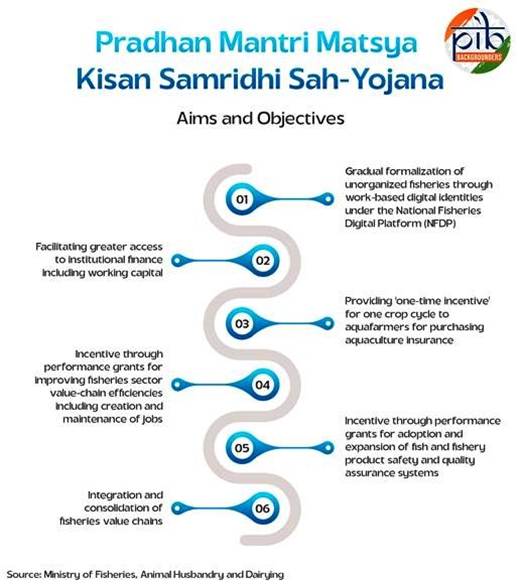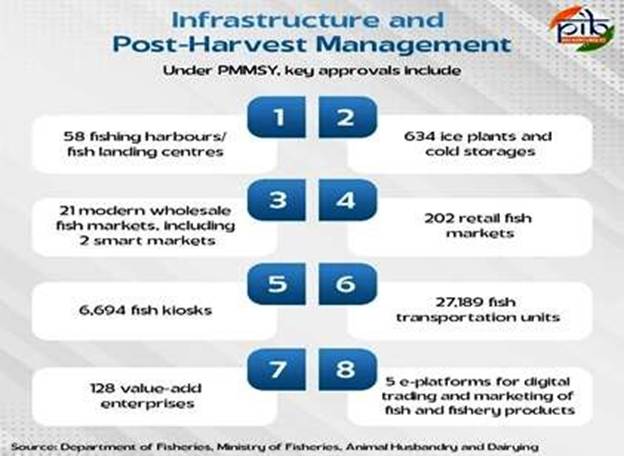Content
- Harnessing the Blue Economy: India’s Fisheries at a Glance
- ISRO’s National Space Meet 2.0 Charts Roadmap for Viksit Bharat 2047 Through Space Applications
Harnessing the Blue Economy: India’s Fisheries at a Glance
What is Blue Economy?
- Concept: Sustainable use of ocean, river, and water resources for economic growth, improved livelihoods, and environmental health.
- Fisheries’ Role:
- Provides food security (protein for millions).
- Generates employment across capture, aquaculture, processing, and marketing.
- Supports exports (major foreign exchange earner).
- Ensures inclusive livelihoods, especially for coastal, inland, and tribal communities.
Relevance : GS 3(Blue Economy)
India’s Global Position
- Second largest fish producing nation after China.
- Contributes ~8% of global fish output.
- Key transformation: shift from capture fisheries → aquaculture-led inland fisheries.

Production Growth (2013–14 → 2024–25)
- Total production: 96 lakh tonnes → 195 lakh tonnes (+104%).
- Inland fisheries: 61 lakh tonnes → 147.37 lakh tonnes (+142%).
- Marine sector: slower growth, but diversification into value-added products.
- Trend: Aquaculture dominance due to RAS, Biofloc, cage culture.

Budgetary Push
- 2025–26 Union Budget: ₹2,703.67 crore (highest ever).
- PMMSY approved projects: ₹21,274.16 crore (till July 2025).
- Infrastructure outlay: ₹17,210.46 crore (till July 2025).
- KCC disbursement: ₹3,214.32 crore to 4.76 lakh fishers/farmers.

Policy Evolution
- Blue Revolution (2015): Productivity, infrastructure, modern practices.
- Limitations: Post-harvest losses, lack of traceability, fisher welfare, weak credit linkages.
- Pradhan Mantri Matsya Sampada Yojana (PMMSY, 2020): Holistic value chain approach, employment, sustainability.
- PM Matsya Kisan Samridhi Sah-Yojana (PM-MKSSY, 2024): Focus on financial inclusion, insurance, digitalisation.

Key Schemes & Mechanisms
a) PM Matsya Sampada Yojana (PMMSY)
- Investment size: ₹20,050 crore (2020–26).
- Objectives: Boost production, traceability, modern infra, fisher welfare.
- Employment: Direct + indirect jobs in fishing, aquaculture, logistics, processing.
- Supported: 2000 co-ops converted into FFPOs + 195 new FFPOs.
b) PM Matsya Kisan Samridhi Sah-Yojana (PM-MKSSY)
- Outlay: ₹6,000 crore (2023–27).
- Focus: Formalisation, insurance, credit, quality standards.
- Early sanction: ₹11.84 crore (April 2025).
- Supported by World Bank & AFD funding.
c) National Fisheries Digital Platform (NFDP)
- Launched Sept 2024.
- Over 26 lakh stakeholders registered by Aug 2025.
- Benefits: Digital IDs, single-window credit access, insurance, traceability.
d) Fisheries & Aquaculture Infrastructure Development Fund (FIDF)
- Fund: ₹7,522.48 crore (2018).
- Extended till 2026 with credit guarantee facility (up to ₹12.5 crore/project).
- 3% interest subvention → minimum credit rate at 5%.
e) Kisan Credit Card (KCC) for Fisheries
- Lending limit raised from ₹2 lakh → ₹5 lakh.
- Issued: 4.76 lakh cards; disbursement: ₹3,214.32 crore (till June 2025).
f) Dharti Aaba Janjatiya Gram Utkarsh Abhiyan
- Tribal-focused: Fish culture support for 10,000 groups + 1 lakh individuals.
- Allocation: ₹375 crore (₹225 cr Centre + ₹150 cr State).
Infrastructure & Modernisation
- Fishing Harbours (Smart & Eco-friendly): Vanakbara (Diu), Karaikal (Puducherry), Jakhau (Gujarat).
- Features: AI-based port management, IoT, e-auctions, solar energy, green waste processing.
- Aquaparks: 11 approved, cost ₹682.60 crore – end-to-end hubs (seed → farming → processing → markets).
- Clusters: 34 notified; organic fisheries clusters in Sikkim & Meghalaya.
Technology Innovations
- Recirculatory Aquaculture System (RAS):
- 12,000 units approved (₹902.97 crore).
- Water reuse + minimal land → high-density aquaculture.
- Biofloc Technology:
- 4,205 units approved (₹523.30 crore).
- “Green soup” → natural feed + water quality management.
- Digitalisation: NFDP, smart harbours, traceability systems.
Inclusivity & Social Impact
- Women in Fisheries: Projects worth ₹3,973.14 crore (2020–25).
- Tribal Empowerment: Dedicated schemes + PMMSY alignment.
- Startups: 39 projects approved (₹31.22 crore subsidy).
- Micro & Small Enterprises: Supported via PM-MKSSY (₹6,000 crore scheme).
International Engagement
- FAO Collaboration (2025): Technical cooperation for “Blue Ports”.
- French Development Bank (AFD): Joint workshop on eco-fishing ports.
- Global Positioning: India aligning with FAO’s “Blue Port Initiative” for climate-resilient fishing hubs.
Challenges & Concerns
- Overfishing in marine sector → sustainability risks.
- Post-harvest losses (~20–25% due to cold chain gaps).
- Climate vulnerability: Cyclones, salinity intrusion, rising sea temps.
- Credit dependence: Small fishers rely on informal borrowing despite KCC.
- Skill gaps: Need for tech adoption training.
Way Forward
- Strengthen export competitiveness: processed fish, value-added aquaculture products.
- Deepen sustainability standards: eco-certifications, traceability.
- Expand insurance & social security to reduce fisher vulnerability.
- Encourage startups & R&D in feed, seed, disease management.
- Promote blue diplomacy: joint ocean governance, marine biodiversity conservation.
- Integrate fisheries into climate adaptation plans.
Conclusion
- India’s fisheries have doubled production in a decade, driven by inland aquaculture, modern tech, and government schemes.
- Schemes like PMMSY & PM-MKSSY are game-changers, enabling digitalisation, inclusivity, and value-chain strengthening.
- With smart harbours, aquaparks, RAS/Biofloc, and tribal/women empowerment initiatives, India is moving towards a sustainable, technology-driven, globally competitive fisheries sector.
- The sector is central to India’s Blue Economy vision, balancing growth, equity, and environmental sustainability.
ISRO’s National Space Meet 2.0 Charts Roadmap for Viksit Bharat 2047 Through Space Applications
Why Space Matters for Viksit Bharat
- Space ≠ Prestige only: It is about applied benefits → governance, livelihoods, environment, disaster response.
- Foundational Role: Satellites + space tech = backbone for agriculture, weather, telecom, navigation, education, healthcare.
- Vision 2047: Space is positioned as a core enabler of socio-economic transformation, not just science.
Relevance : GS 2(Governance) ,GS 3(Space)
Context of National Space Meet 2.0
- Occasion: 2nd National Space Day (commemorating Chandrayaan-3’s Vikram lander soft landing).
- Venue: Bharat Mandapam, New Delhi.
- Participants: Govt ministries (60+), states/UTs, industry, academia, startups, experts, citizens.
- Background: Similar meet in 2015 → shaped governance reforms through space apps over the last decade.
- Goal: Define roadmap for Viksit Bharat 2047 via whole-of-government + whole-of-nation approach.
Structure of the Meet
- 10 breakout sessions → domain-specific problem solving:
- Agriculture & Water
- Forests, Environment & Energy Policy
- Infrastructure & Geo-Governance
- Health, Education & Social Welfare
- Communication, Navigation & Tech Diffusion
- Disaster Risk Reduction
- Ocean, Weather, Earth Resources
- North-Eastern Region & Hilly States
- Coastal States/UTs
- Inland States/UTs
- Hundreds of experts worked 4 months pre-meet to build ready-to-implement use cases.
Highlights from Leadership
- Space = Earth-centric tool: Focus on agriculture, health, disaster resilience, climate monitoring.
- Whole-of-Government adoption: 60+ ministries use space tech in governance.
- Startup boom: 2 (2014) → 350+ (2025), driven by reforms, VC support, and tech transfers.
- Next-gen push: AI, quantum computing, big data integrated into satellites + ground infra.
- Private sector role: Innovation engine; startups seen as part of national mission.
- Roadmap to 2040:
- Autonomous constellations & integrated systems.
- Space embedded in food, water, energy, environment, governance.
- India on par with global leaders in rockets, satellites, applications.
- Policy & Strategy: Geospatial Policy 2022, Indian Space Policy 2023, IN-SPACe regulator.
- Strategic security: Indigenous, resilient space infrastructure crucial for defence.
- Global leadership vision: International Alliance on Space for debris, surveillance, mining, energy.
Roadmap Announced
a) Satellite Targets
- Triple operational satellites in 3 years.
- 119 satellites by 2040 → EO, SATNAV, SATCOM.
b) Application Strategy
- Govt-led satellites → societal/gov services (medium–coarse resolution EO, NAVIC).
- PPP-led satellites → high-res EO, comm satellites for commercial viability.
- Expand EO + SATNAV + SATCOM → mainstream governance and economy.
c) Technology Agenda
- AI, quantum, big data → integrated with satellite & ground infra.
- New-generation instruments, autonomous constellations, advanced launchers.
- Strengthen infra for tech demonstration (DoS + ISRO lead).
Key Themes Emerging
- Space for Governance: Agriculture monitoring, e-learning, telemedicine, disaster warning, fisheries, urban planning.
- Startup Ecosystem: Space startups now >350, spanning launch, satellites, data analytics.
- Reforms Backbone: Indian Space Policy 2023, IN-SPACe, liberalised FDI, PPP.
- Security Dimension: Defence use of satellites + protection from space threats.
- Global Role: India moving from user → leader in space diplomacy & climate satellites.
Challenges Identified
- Balancing commercialisation vs sovereignty in space.
- Need for resilient indigenous infra (anti-satellite threats, cyber risks).
- Addressing space debris & sustainability as satellite count rises.
- Bridging capacity gap → training officials, startups, states to use satellite data effectively.
- Financing challenges for space-tech SMEs.
Way Forward (Viksit Bharat 2047 Vision)
- Institutionalise National Space Meet annually for continuous roadmap.
- Expand Pan-India consultative mechanism to aggregate demand for EO/Comm/Nav services.
- Build global alliances for climate, debris, mining, legal governance.
- Strengthen PPP ecosystem: startups scale from innovation → execution.
- Space to become foundational infra: like railways (19th c.), electricity (20th c.), internet (21st c.).
Conclusion
- ISRO’s National Space Meet 2.0 marks a shift from symbolic achievements to systemic transformation.
- Space will act as the connective tissue of governance, touching every citizen: farmer, student, patient, fisher, disaster survivor.
- India’s space journey = from Thumba rocket launches → global leadership by 2040.
- By 2047, space technology is envisioned as a pillar of Viksit Bharat, ensuring inclusivity, resilience, and global competitiveness.



